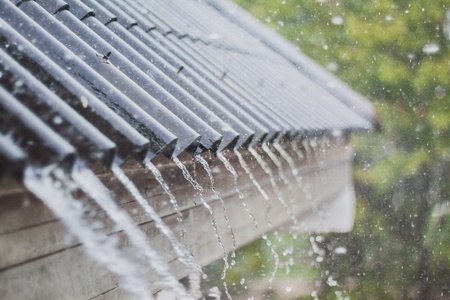Image copyright: 4elevens / 123RF Stock Photo
One thing we’re not short of in the westcountry is rainwater and it is a shame to let it go to waste. But one look at the guttering following a heavy downpour will probably convince you that it might not be wise to use water directly from your roof for drinking.
And if you can help it, it is probably best to err on the safe side and use the rainwater than runs off your roof for alternative domestic purposes (such as watering the plants, washing clothes and bathing.)
However, as long as you are not living too close to a volcano, chemical plant or power station (especially of the nuclear variety) and providing it is treated properly after harvesting, water from your roof can be potable. In order to ensure the water from your roof can be used for drinking it is important to follow some common sense guidelines as described below:
Clean your Roof and Rainwater Goods First
While some people swear that as long as you follow the ‘First Wash’ rule (i.e. the disposing of at least the first 10 gallons of water collected), you can drink off practically any roof, it is far better to give your roof and rainwater goods a good clean before harvesting. Leaves, dirt, animal waste, insect parts, agricultural chemicals and industrial discharge are just a few of the nasties that are likely to have accumulated on a dirty roof.
But Won’t Rainwater from your Roof be Acidic?
Yes it will, but it’s unlikely to be anything to be concerned about. Acidity is measured on a pH scale where 7.0 is considered neutral and anything below this is acidic. Rainwater is unlikely to be less than 5.5 on the scale which is the range at which tooth enamel starts to erode. To put this in context, your morning cup of coffee is likely to be between 4.5 and 6.5; orange juice comes in at 3.0 to 4.0 and can of fizzy drink could be as low as 2.5!
One issue with the acidity of rainwater though is the fact that it will dissolve numerous chemicals (not to mention bird droppings) as it runs down your roof. A study from Texas found that asphalt roofs and, surprisingly, green roofs contained higher than recommended amounts of dissolved carbon (DOC) which can , under some circumstances, combine with chlorine to produce a carcinogenic (potentially cancer-causing) chemical. In an Australian study, levels of lead were also found to be slightly raised in dirty metal roofs but this was not the case if the roof had been pre-cleaned (of course, drinking rainwater from a lead roof is not recommended). Otherwise, the levels of chemicals present, even in rainwater from dirty roofs, were well below recommended levels.
Removing Biological and Chemical Contaminants from your Roof Water
Although another Australian study found no link between drinking pure, unfiltered rainwater and increased gastro-intestinal illness, you will almost certainly want to filter your harvested rainwater prior to consumption. A good quality water filter will remove debris and harmful chemicals from the water and leave it almost potable. However, filtering will not remove any harmful micro-organisms so most people will boil the filtered water before drinking it. Some filter systems claim to remove biological contaminants too, but these should be treated with some skepticism.
If you are serious about harvesting rainwater from your roof (and let’s make it clear we are NOT advocating this), installing new Aluminium flashing and rainwater goods are recommended and keeping them clean and well-maintained. To upgrade your flashing or change your roof material, get in touch with JS Cladding and Roofing for advice.
Visit this link for all the data from the Australian study.
